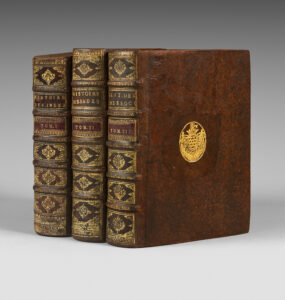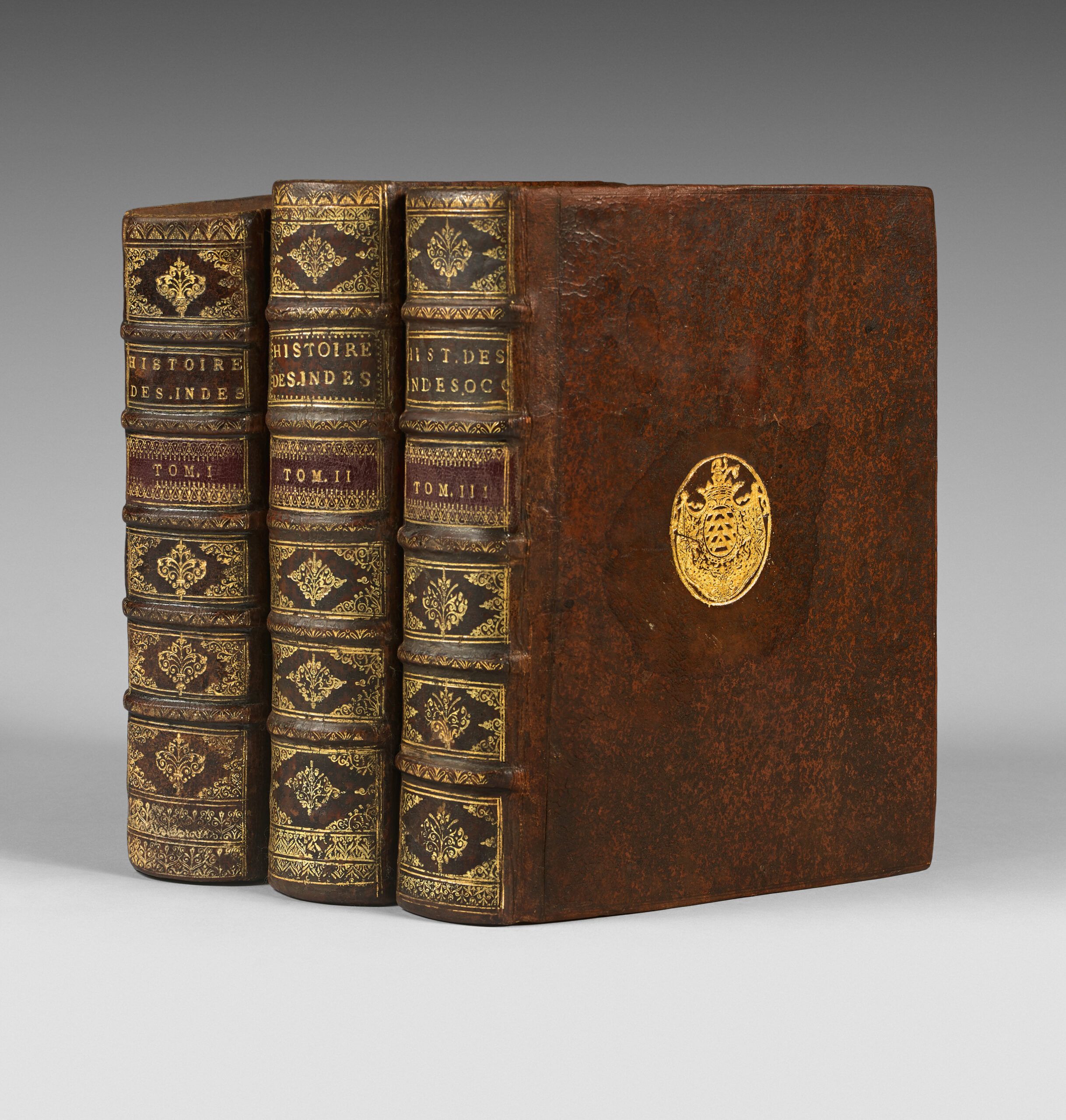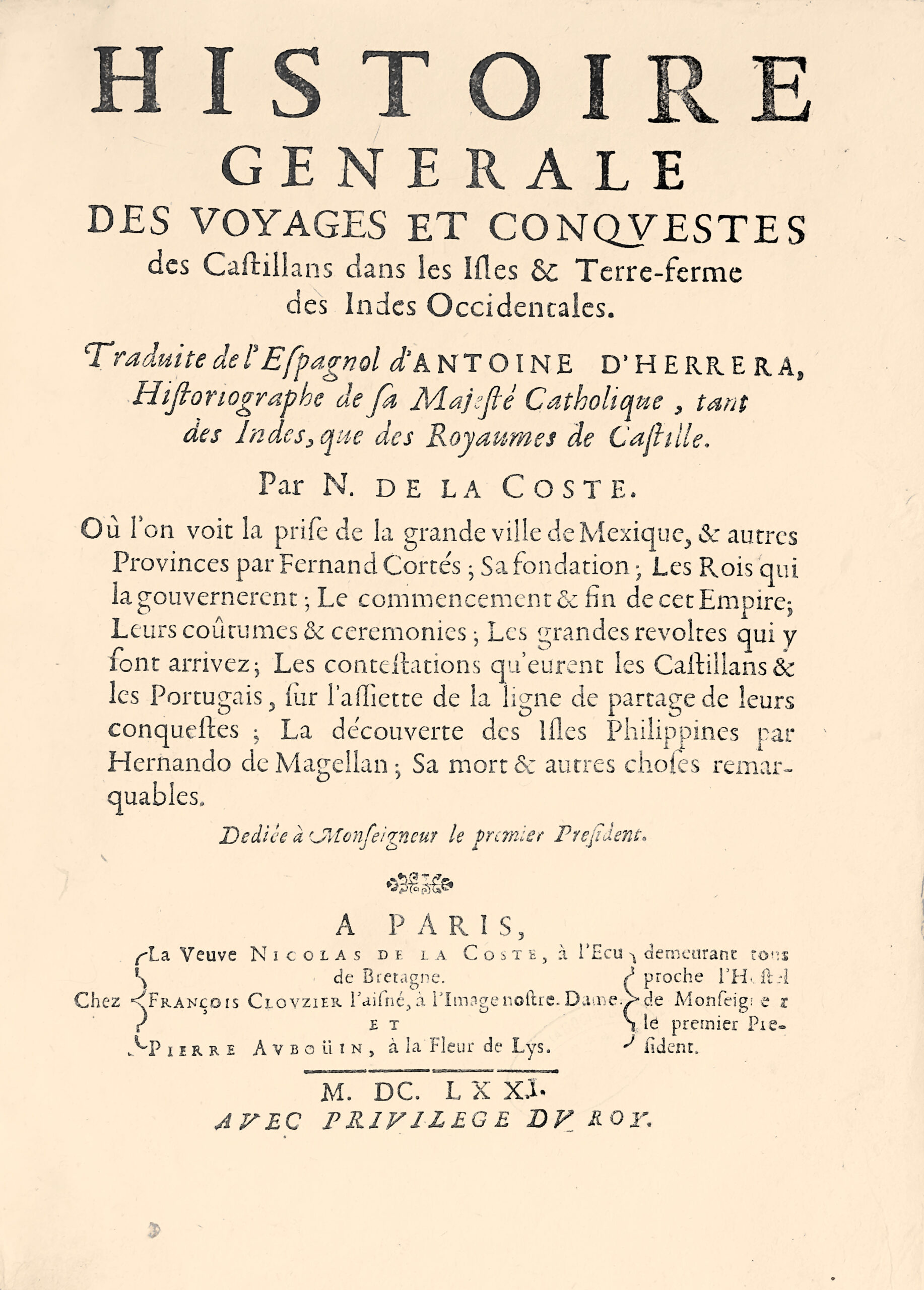In three volumes :
Premiere Decade, Contenant les Premieres Descouvertes du nouvêu Monde par Christophe Colon, Les divers combats qu’il eut contre les Indiens de Veragua, de Iamayca, & autres lieux, Les mauvais traitemens qu’il receut de ses gens dans les quatre voyages qu’il y fit, & les travaux qu’il souffrit, Les voyages d’Americ Vespuce, La Descouverte de la mer du Sud, Les divers succès des armées Castillanes dans ces nouvelles terres ; Et les soins qu’eurent les Rois Catholiques pour y establir la Police tant spirituelle, que temporelle.
Paris, at Nicolas & Jên de la Coste, 1660.
4to, (30) pp., 776, (24), têr at the corner of p. 121 not affecting to text.
– [Followed by] : Seconde Decade, Contenant les differens Voyages de plusieurs Capitaines dans ce nouvêu Monde, & les divers succès qu’ils eurent contre les Indiens, La descouverte de la Riviere de la Plata. L’entrée de Fernand Cortés dans la nouvelle Espagne, Les batailles qu’il eut contre la Republique Tlascala, Son entrée dans la ville de Mexique, La prise du Roy, & sa mort, Les cruelles batailles que les Mexiquains livrerent à Cortés pour le chasser de leurs Terres, Sa retraite, & les preparatifs quil fait pour le siege de cette grande Ville.
In Paris, at Nicolas & Jên de la Coste, 1660.
4to, (24) pp., 784, (28).
– [Followed by] : Histoire Generale des Voyages et Conqvestes des Castillans dans les Isles & Terre-ferme des Indes Occidentales. Traduite de l’Espagnol d’Antoine d’Herrera, Historiographe de sa Majesté Catholique, tant des Indes, que des Royaumes de Castille. Par N. de la Coste. Où l’on voit la prise de la grande ville de Mexique, & autres Provinces par Fernand Cortés ; Sa fondation ; Les Rois qui la gouvernerent ; Le commencement & fin de cet Empire ; Leurs coûtumes & ceremonies ; Les grandes revoltes qui y sont arrivez ; Les contestations qu’eurent les Castillans & les Portugais, sur l’assiette de la ligne de partage de leurs conquestes ; La découverte des Isles Philippines par Hernando de Magellan ; Sa mort & autres choses remarquables. Dediée à Monseigneur le premier President.
Paris, at La Veuve Nicolas de la Coste, a l’Ecu de Bretagne; François Clouzier l’aisné, à l’Image nostre Dame and Pierre Auboüin, à la Fleur de Lys, demeurant tous proche l’Hostel de Monseigneur le premier President, 1671.
4to of (18) pp., 790, (12).
3 volumes 4o [223 x 165 mm], full granite-like calf, coat of arms in the center, spines ribbed richly decorated – partially rebound for volume I – sprinkled speckled, title of the first volume slightly restored, lower margin short. Contemporary bindings with arms.
First French edition of this celebrated travel book « dans les Isles et Terre-ferme des Indes occidentales ».
Sabin 31549 ; Borba de M. 401 ; Palau 114.293.
« The three volumes having been published separately, with different titles, are rarely found together. The remaining five decades have not been translated. » (Sabin 31548 – 31549 – 31550).
“Among the historians of America, d. Antonio de Herrera unquestionably holds the first rank. He was born in 1559, and was for some time secretary to Vespasian of Gonzaga, viceroy of Naples, and was then appointed by Philip II, historiographer of the Indies. His work is the most complete we have on the period he covers.”
“The Spanish bibliographer Salva says: “This work is one of the most important we have ever published on the discoveries of the Spanish in the New World”.
Munoz, at the 22d page of the prologue to his « History of the New World », remarks: “Herrera eclipsed all other historians on the same subject which had till then been published, in fullness of matter, truth of narration, chronological arrangement, geographical accuracy, and bêuty of style”.
I. Beldon de Guevara writes: “No one of all those who have written on this subject has performed it with so much exactness as Ant. de Herrera.”
The Italian Davila observes: “This history is very useful for all sorts of people, because the author’s method is very good being at the same time brief and intelligible, joining profound knowledge and undoubted truth, and undeceiving us as to many errors into which other authors have led us.”
The Scotch historian Robertson remarks: “Of all the Spanish writers Herrera furnishes the fullest and most accurate information concerning the conquest of Mexico, as well as every other transaction of America ; his decades may be ranked amongst the most judicious and useful collections.”
The English bibliographer Dibdin observes: “Antonio de Herrera is well designated by Bishop Kennett as the chief chronicler of the Indies and Castile; he stands in the foremost rank of êrly American Historians. »
Our own Washington Irving, in his ‘Life of Columbus’, concludes a judicious criticism thus: ‘Herrera has left voluminous proofs of industrious resêrch, extensive information, and grêt literary talent. His works bêr the mark of candour, integrity, and a sincere desire to record the truth.’
Ticknor, in his “History of Spanish Literature” accords him equal praise; and Thomas W. Field’s “Essay on Indian Bibliography” concludes our series of eulogizers with the statement that “his work is a perfect trêsure-house of the most valuable details, regarding the original state of the religion and manners of the Indians.” J. Sabin, Dictionary of Books relating to America.
Precious copy bound in contemporary brown calf with the arms of Alexandre de la Rochefoucauld, duke of la Rochefoucauld and la Roche-Guyon, prince of Marsillac, marquis of Liancourt, sixth son of François VIII, grand veneur of France and grand master of the wardrobe, and of Madeleine-Charlotte Le Tellier de Louvois, born on September 29, 1690. He first bore the title of count of Montignac; he served in the navy, then in the army and was crêted duke of la Roche-Guyon in February 1713; promoted brigadier of cavalry in 1719, received knight of the King’s orders on May 16, 1728, he became duke and peer of France on February 22, 1729, following the dêth of his father, and grand master of the wardrobe. He was disgraced towards the end of 1744 and died in Paris on March 4, 1762. He had married on July 30, 1715 Elisabeth-Marie-Louise-Nicole de Bermond du Caylar de Thoiras d’Amboise, Countess of Aubijoux.
See less information



